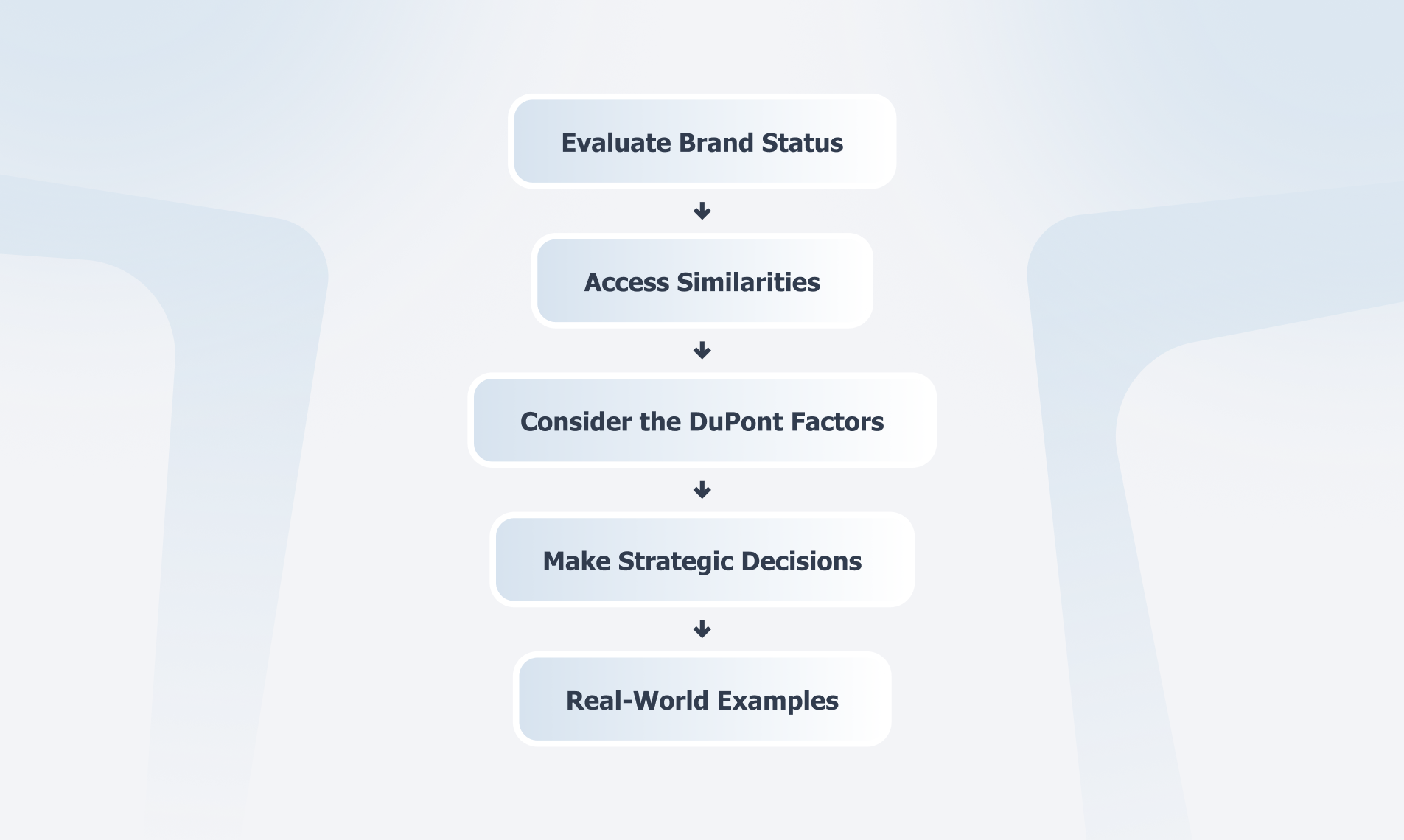Overview
This article presents a four-step process for conducting an effective Trademark Electronic Search System (TESS) search, a crucial practice for identifying potential conflicts with existing trademarks and enhancing brand strategy. It underscores the significance of:
- Thorough preparation
- The application of diverse search techniques
- Careful analysis of results
- The necessity of making informed decisions to mitigate risks and bolster the likelihood of successful trademark registration.
By following these steps, businesses can navigate the complexities of intellectual property management with confidence and precision.
Introduction
In the intricate world of trademark registration, navigating the complexities of the Trademark Electronic Search System (TESS) is paramount for aspiring brand owners. As the first line of defense against potential conflicts, TESS serves as a critical tool for identifying existing trademarks that could pose challenges to new applications. With the stakes high and costs associated with trademark filings on the rise, understanding how to effectively utilize this resource can mean the difference between a successful registration and costly legal disputes.
This article delves into the essential steps and strategies for mastering TESS, from preparation and execution to analyzing search results. By ensuring that trademark applicants are well-equipped to safeguard their intellectual property in an increasingly competitive landscape, we aim to empower you in your journey toward effective IP management.
Understand the TESS System and Its Importance
The TESS search, or Trademark Electronic Search System, serves as a crucial resource provided by the United States Patent and Trademark Office, enabling users to locate both registered and pending marks. For anyone aiming to register a brand, expertise in this system is indispensable, as it facilitates the identification of existing brands that may conflict with your proposed mark. With access to an extensive database, the TESS search delivers vital insights into potential risks, ensuring that your brand application is not only distinct but also defensible. Utilizing the TESS search not only aids in avoiding brand infringement but also significantly enhances your overall brand strategy.
In 2023, the average cost of submitting a brand registration request was $275, underscoring the necessity of conducting thorough inquiries to mitigate the risks associated with flawed applications. The cost of hiring a lawyer pales in comparison to the potential losses from a problematic brand application, highlighting the importance of a comprehensive search process.
Moreover, the rise in brand disputes—particularly those related to domain names, which have increased by 10% annually over the past five years—emphasizes the need for robust online brand protection. This trend underscores the critical role of the TESS search in safeguarding brand identifiers in the digital landscape, thereby preserving brand integrity and preventing consumer confusion. Additionally, the USPTO provides access to the Trademark Trial and Appeal Board Reading Room, a valuable resource for corporate IP managers seeking to understand brand identifier decisions and strategies. Expert insights reinforce this perspective, with professionals asserting that ‘skill, experience, and attention to detail play an essential role in mitigating the potential risks that could hinder a successful registration.’ Familiarity with the system not only aids in preventing infringement but also bolsters your brand strategy for greater success, particularly in light of the challenges posed by brand disputes and the necessity for informed decision-making.
Prepare for Your TESS Search: Essential Steps
To effectively prepare for your tess search, follow these crucial steps:
- Identify Your Brand: Clearly define the brand you wish to look for, whether it’s a name, logo, or slogan. Consider variations, including plurals and synonyms, to ensure a thorough exploration.
- Draft a List of Keywords: Compile a list of keywords associated with your trademark. This method expands your scope of inquiry and assists in capturing similar marks, enhancing the chances of recognizing potential conflicts. Expert guidance recommends concentrating on both broad and specific terms to improve retrieval effectiveness.
- Choose the Right Search Method: Familiarize yourself with the various options available in the tess search, such as Basic Word Mark Search, Structured Search, and Free Form Search. Each method serves distinct purposes and can yield different results, so choosing the appropriate one is vital for effective brand identification.
- Gather Necessary Information: Collect relevant details about your brand, including its intended use and the goods or services it will represent. This context is essential for refining your search and ensuring that you cover all bases. Furthermore, think about using the USPTO’s ‘Trademark Trial and Appeal Board Reading Room’ for access to TTAB decisions, which can offer additional insights into brand disputes and trends.
In 2023, 80% of brand applications included a logo or design element, highlighting the importance of visual branding in brand registration. By refining your inquiry with keywords and comprehending the subtleties of the system, you can improve your likelihood of successful brand registration. Furthermore, historical trademark data indicates trends in classes and categories that are gaining traction, which can inform your strategy. Incorporating these insights and thorough preparation can lead to a higher percentage of successful registrations, particularly when leveraging keyword optimization strategies.
Execute Your TESS Search: Techniques and Strategies
To conduct an effective tess search inquiry, consider the following techniques and strategies:
- Utilize Boolean Operators: Employ Boolean operators such as AND, OR, and NOT to enhance your results. For instance, utilizing ‘AND’ enables you to discover trademarks that include multiple keywords, while ‘OR’ broadens your inquiry to encompass variations, thereby improving the scope of your results. These operators serve as conduits for refining and focusing your queries.
- Leverage Field Tags: Field tags are essential for refining your inquiry. By searching with specific criteria, such as owner name or registration number, you can obtain more targeted results, thus making your inquiry process more efficient.
- Perform Various Queries: Relying on a single inquiry can yield insufficient outcomes. It is crucial to conduct multiple inquiries using diverse keywords and techniques to ensure thorough coverage of potential trademarks.
- Review Similar Marks: Analyze similar marks that may not be identical but could still present conflicts. Assess their products/services and market presence to evaluate potential risks effectively, utilizing tess search to adjust the default number of records displayed per page to 30 or 50 for a more customized browsing experience.
Interacting with resources such as the National IPR Center can enhance your ability to safeguard your rights and address reported infringements efficiently, underscoring the importance of comprehensive brand name investigations. Implementing these tactics not only boosts the efficiency of your database inquiries through tess search but also increases the likelihood of detecting potential brand name disputes, thereby protecting your intellectual property rights.
Disclaimer: This article does not serve as legal counsel or establish an attorney/client relationship.
Analyze TESS Search Results: Making Informed Decisions
Analyzing the results of your tess search is crucial for making informed trademark decisions. To guide you through this process, consider the following structured approach:
- Evaluate Brand Status: Start by determining whether the brands identified in your search are live or dead. Active marks are currently in use and may pose potential conflicts, while inactive marks might be available for your utilization. Notably, statistics indicate that approximately 70% of brand names in the TESS search system are inactive, highlighting significant opportunities for new registrations.
- Assess Similarities: Examine the phonetic and conceptual similarities between your proposed brand name and existing marks. Pay close attention to their relation in terms of goods and services, as well as the target markets. This evaluation is essential; even minor similarities can lead to confusion and potential legal challenges.
- Consider the DuPont Factors: Utilize the DuPont factors to assess the possibility of confusion between your brand and existing ones. Key factors include the similarity of the marks, the relatedness of the goods and services, and the channels of trade. Understanding these components can significantly impact your brand strategy.
- Make Strategic Decisions: After thorough analysis, decide whether to proceed with your brand application, modify your proposed brand, or conduct additional searches. This strategic approach not only mitigates risks but also enhances your chances of successful registration. For instance, the USPTO’s Accelerated Examination program allows for expedited processing within three months for an additional fee, which can be beneficial for timely market entry.
Real-world examples illustrate that companies employing thorough tess search analysis have effectively managed brand challenges, underscoring the significance of a careful evaluation process. Furthermore, the USPTO’s Trademark Fraud Program, which examines deceptive assertions in application submissions, emphasizes the importance of upholding integrity in application processes. This further highlights the need for careful analysis of search results. As Cindy Waddle, Founder and CEO of Dezire to Inspire, LLC, states, “Dezire to Inspire offers the tools to begin the change we need to see in the world,” reinforcing the importance of utilizing the right resources in trademark analysis.

Conclusion
Navigating the complexities of the Trademark Electronic Search System (TESS) is essential for anyone looking to secure a trademark.
Understanding the importance of TESS—its role in identifying potential conflicts and its influence on overall trademark strategy—is fundamental for aspiring brand owners. By following the outlined steps for preparation, execution, and analysis, applicants can significantly reduce the risks associated with trademark registration.
Effective use of TESS not only safeguards against infringement but also positions trademarks for success in a competitive landscape. By leveraging techniques such as Boolean operators and field tags, along with conducting thorough evaluations of search results, applicants can make informed decisions that enhance their chances of successful registration. The insights gained from TESS can be pivotal in shaping a robust trademark strategy that withstands the challenges posed by trademark disputes.
Ultimately, mastering the TESS system empowers brand owners to protect their intellectual property effectively. As the landscape of trademark registration continues to evolve, staying informed and proactive in utilizing TESS will be key to navigating potential conflicts and achieving long-term brand success.
Master TESS and Safeguard Your Brand Today! Start now with iPNOTE and streamline your trademark registration process for lasting success.
Frequently Asked Questions
What is the TESS search?
The TESS search, or Trademark Electronic Search System, is a resource provided by the United States Patent and Trademark Office that allows users to locate both registered and pending trademarks.
Why is expertise in the TESS system important for brand registration?
Expertise in the TESS system is crucial for identifying existing trademarks that may conflict with your proposed mark, helping to ensure that your brand application is distinct and defensible.
How does the TESS search contribute to brand strategy?
Utilizing the TESS search helps avoid brand infringement and significantly enhances overall brand strategy by providing vital insights into potential risks associated with trademark applications.
What is the average cost of submitting a brand registration request in 2023?
In 2023, the average cost of submitting a brand registration request was $275.
Why is it important to conduct thorough inquiries before applying for a trademark?
Conducting thorough inquiries is essential to mitigate the risks associated with flawed applications, as the cost of hiring a lawyer is significantly lower than the potential losses from a problematic brand application.
What trend has been observed regarding brand disputes?
There has been a 10% annual increase in brand disputes related to domain names over the past five years, highlighting the need for robust online brand protection.
How does the TESS search help in safeguarding brand identifiers?
The TESS search plays a critical role in protecting brand identifiers in the digital landscape, preserving brand integrity, and preventing consumer confusion.
What additional resource does the USPTO provide for understanding brand identifier decisions?
The USPTO provides access to the Trademark Trial and Appeal Board Reading Room, which is a valuable resource for corporate IP managers seeking to understand brand identifier decisions and strategies.
What do experts say about the factors that contribute to successful trademark registration?
Experts emphasize that skill, experience, and attention to detail are essential in mitigating potential risks that could hinder successful trademark registration.






